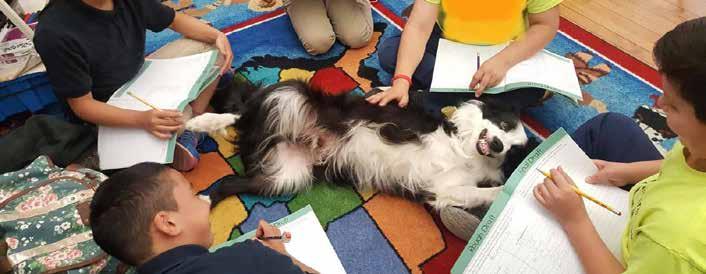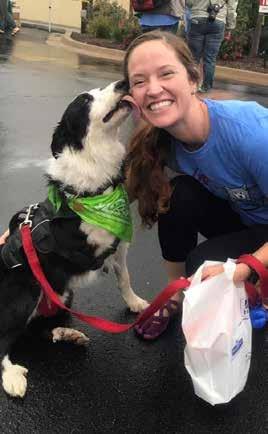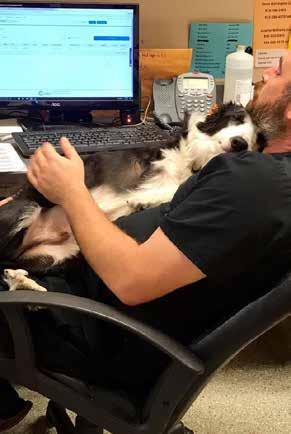
5 minute read
NONPROFIT
A Home for the Holidays.
For most, the holidays mean heading home to celebrate with loved ones — but some furry members of our community aren’t so lucky. Throughout the metro, many dogs, cats, and other animals will be waiting to meet their future families in shelters.
Advertisement
Winter can be a little slower for pet adoptions, says Tori Fugate, KC Pet Project’s director of marketing and communications, but the shelter constantly engages with the community through adoption specials and events. A public-private partnership, the organization is a nonprofit that has served as Kansas City, Missouri’s shelter since 2011, taking in strays as well as surrendered animals throughout the city. KC Pet Project now cares for 10,000 animals each year.
“We took over this shelter that had a long history of euthanizing animals, and the city wanted something different,” Fugate says. “We knew we could do better and at least try to save more lives, and since 2011 we have been saving over 90 percent of the animals that have come into the shelter.”
Last year, the shelter adopted out more than 6,700 animals and reunited more than 1,200 pets and owners. And KC Pet Project’s success isn’t just good news for Kansas City animals — it’s become an example and resource for other organizations around the country.
“So many other shelters in bigger cities have reached out to us asking how we’ve done it, and they are wanting to use the same model in their cities to save lives,” Fugate explains.
RESCUES UNLEASHED
A passion for helping animals led Danielle Reno to found another area shelter, Unleashed Pet Rescue, in 2011. Today, Unleashed gets about 100 animals in each week, housing them in the shelter or placing them with foster families. Its foster program is extensive, with 500 animals currently being cared for, says Rebecca Taylor, Unleashed’s social media and public relations director.
Unleashed also brings in animals from other regional shelters that are struggling to find homes and rescues


animals from abuse and neglect.
“Really, there isn’t a place that doesn’t need help with rescue — rural areas, cities, it’s just kind of nonstop,” Taylor says. “We don’t sleep very much in rescue. We work a lot and we’re all very passionate and dedicated, so we’re lucky to have so many supportive people around us that want to help.”
The shelter is entirely funded by donations, which often come in through Facebook, where Taylor shares the heart-wrenching plights of pets in Unleashed’s care, as well as lighter fare, like the sweet bonds between pets and their foster families. In addition to raising money, it helps people get to know the kinds of animals that are in shelters.
“A lot of rescue animals aren’t “broken,” they’re people’s dogs that have been trained, puppies that need help, kittens that need help,” she says.
Unleashed pays special attention to “bully breeds,” a category that often makes up a significant portion of shelters’ populations because of misconceptions about the animals. Taylor says the shelter likes to educate the community about what kinds of dogs they really are — sweet, smart, and adaptable.
EDUCATING FUTURE PET OWNERS
For Wayside Waifs, educating people about animals is a vital part of the mission, says Casey Waugh, the shelter’s communications and annual giving manager.
“We here at Wayside really see that part of the reason there is a stigma with different animals, whether they’re not accepted in homes, whether they’re treated poorly, whether people just don’t know how to interact [with them], is because of how people have been raised,” she explains.
THE ULTIMATE GIFT OF A PET
’Tis the season ... for giving pets as presents. Before you adopt this holiday season, the experts suggest:
• Picking a pet as a family. “If children are coming in and this is going to be their potential first pet, it’s really great for them to also be involved in the process. They feel that investment of picking out the pet and making it their own,” Fugate says. “They’re going to want to help care for it.” Bringing kids with you to the shelter instead of surprising them with a pet also ensures that you’re bringing home an animal that is friendly toward kids, something that can be hard to test for in the shelter.
• Considering your lifestyle. Part of the role of a shelter’s staff is to help you find the right animal for the way you live, Taylor says. Think about how often you’re home, your activity level, and what you want in a pet versus what’s realistically the best fit.
• Taking your time. It’s okay to make multiple visits to animals at a shelter, Taylor says. You might need to spend time with several animals to find your new furry friend, or you might know instantly. Based on her experience, she says “animals pick their families, and you just have to pay attention.”

The shelter’s education programs focus on kids. One program allows them to read to shelter animals so they can build confidence in their skills, and groups of kids from schools and organizations will often come in to tour the shelter and participate in a volunteer project. Wayside Waifs also created the “No More Bullying” program, which puts humane educators, both human and canine, in third-grade through fifth-grade classrooms. The curriculum teaches students that animals have feelings, too, and emphasizes the value of showing kindness and compassion to everyone.
One of the humane education animals is Patrick, who came to Wayside with a problem in one of his legs that required amputation.
“He’s got a smile that lights up the room, and kids just love him,” Waugh says. “It’s great to have him come in because we can talk about ‘he has three legs; he’s different from every other dog, but that doesn’t make him different inside.’”
Learning about Patrick allows kids who might be going through their own struggles or feeling different understand they’re not alone, she says.
It’s one of the many ways shelters help not just animals, but whole communities.
“A lot of times, people think we’re in rescue just because we love animals,” Taylor says. “Of course we love animals, but we want to people to get joy and happiness from animals — so we want to help people too. That’s what this is all about.” Kelsey Cipolla is a local writer, editor, and social media specialist. Kelsey has covered everything from the Kansas City culinary scene to home design, health, fitness trends, hidden gems, and nonprofit in the Kansas City community.





